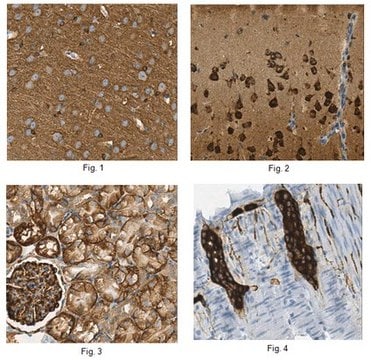MAB2241
Anti-Tau Antibody, clone Tau 12
clone Tau 12, from mouse
Synonym(s):
G protein beta1/gamma2 subunit-interacting factor 1, Neurofibrillary tangle protein, Paired helical filament-tau, microtubule-associated protein tau, microtubule-associated protein tau, isoform 4
Sign Into View Organizational & Contract Pricing
All Photos(1)
About This Item
UNSPSC Code:
12352203
eCl@ss:
32160702
NACRES:
NA.41
Recommended Products
General description
Microtubule Associated Proteins, or MAPS, bind to the tubulin subunits of microtubule structures and regulate their functional stability. In the cell MAPs bind to monomer and multimerized tubulin. MAP binding to multimerized tubulin further stabilizes the formation of higher order microtubulin structures. MAP binding to microtubule structures is mediated through phosphorylation through Microtubule Affinity Regulated Kinase (MARK). Phosphorylation releases MAPs bound to microtubules, destabilizing the structure, driving it toward disassembly. There are predominately two MAP types, I, II. Type II MAP includes MAP2, MAP4, and tau and are found in nervous tissue. Six tau isoforms exist in brain tissue, and they are distinguished by their number of binding domains. Three isoforms have three binding domains and the other three have four binding domains. The binding domains are located in the carboxy-terminus of the protein and are positively-charged (allowing it to bind to the negatively-charged microtubule). The isoforms with four binding domains are better at stabilizing microtubules than those with three binding domains.
Specificity
Cat. # MAB2241 recognizes the N-terminus region of Tau.
Reactivity with other species has not been determined.
Immunogen
Epitope: N-terminus
KLH conjugated synthetic linear peptide.
Application
Anti-Tau Antibody, clone Tau 12 is an antibody against Tau for use in WB.
Research Category
Neuroscience
Neuroscience
Research Sub Category
Neurodegenerative Diseases
Neurodegenerative Diseases
Quality
Western Blot:
Target description
50-68 kDa
Linkage
Replaces: MAB10417
Physical form
Format: Purified
Protein G Purified
Purified in 0.1M Tris-Glycine (pH7.4) 150mM NaCl with 0.05% NaN3.
Storage and Stability
Stable for 1 year at 2-8ºC from date of receipt.
Analysis Note
Control
Human brain tissue lysate.
Human brain tissue lysate.
Other Notes
Concentration: Please refer to the Certificate of Analysis for the lot-specific concentration.
Disclaimer
Unless otherwise stated in our catalog or other company documentation accompanying the product(s), our products are intended for research use only and are not to be used for any other purpose, which includes but is not limited to, unauthorized commercial uses, in vitro diagnostic uses, ex vivo or in vivo therapeutic uses or any type of consumption or application to humans or animals.
recommended
Product No.
Description
Pricing
Storage Class Code
12 - Non Combustible Liquids
WGK
WGK 1
Flash Point(F)
Not applicable
Flash Point(C)
Not applicable
Certificates of Analysis (COA)
Search for Certificates of Analysis (COA) by entering the products Lot/Batch Number. Lot and Batch Numbers can be found on a product’s label following the words ‘Lot’ or ‘Batch’.
Already Own This Product?
Find documentation for the products that you have recently purchased in the Document Library.
Hiroki Takeuchi et al.
NPJ vaccines, 5, 28-28 (2020-03-29)
Pathological aggregates of tau proteins accumulate in the brains of neurodegenerative tauopathies including Alzheimer's disease and frontotemporal lobar degeneration (FTLD-tau). Although immunotherapies of these disorders against tau are emerging, it is unknown whether nasal delivery, which offers many benefits over
April L Darling et al.
Protein science : a publication of the Protein Society, 30(7), 1350-1359 (2021-03-10)
Alzheimer's disease is a progressive fatal neurodegenerative disease with no cure or effective treatments. The hallmarks of disease include extracellular plaques and intracellular tangles of aggregated protein. The intracellular tangles consist of the microtubule associated protein tau. Preventing the pathological
Michael J Ellis et al.
Acta neuropathologica, 147(1), 87-87 (2024-05-18)
Antibodies are essential research tools whose performance directly impacts research conclusions and reproducibility. Owing to its central role in Alzheimer's disease and other dementias, hundreds of distinct antibody clones have been developed against the microtubule-associated protein Tau and its multiple
Francesc X Guix et al.
International journal of molecular sciences, 19(3) (2018-03-03)
Progressive cerebral accumulation of tau aggregates is a defining feature of Alzheimer's disease (AD). A popular theory that seeks to explain the apparent spread of neurofibrillary tangle pathology proposes that aggregated tau is passed from neuron to neuron. Such a
Juan Ramón Perea et al.
Experimental neurology, 310, 14-21 (2018-08-24)
Tauopathies are a broad set of neurodegenerative dementias characterized by the aggregation of Tau protein. Activated microglia and elevated levels of pro-inflammatory molecules are also pathological hallmarks of tauopathies. In these diseases, intracellular Tau is secreted to the extracellular space
Our team of scientists has experience in all areas of research including Life Science, Material Science, Chemical Synthesis, Chromatography, Analytical and many others.
Contact Technical Service





